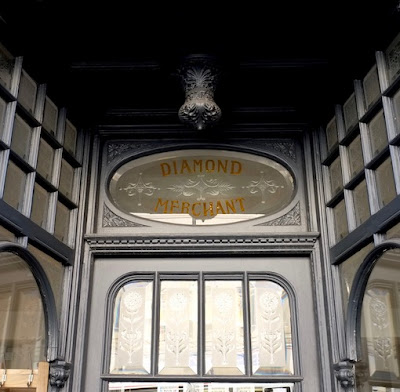Bling and beer
Grantham when I last passed through (a few years ago on a summer evening), was as closed as it must have been recently: hardly any shops open, St Wulfram’s church closed, nowhere much opening hospitable doors. Drifting along the quiet High Street, I spotted this, above a shop door adjacent to the facade of what was once the George Inn, a building mentioned in Nicholas Nickleby and bearing a plaque to Grantham’s most famous son, Sir Isaac Newton. The front of this building looks much later than the George. It seems to speak of the fashion for small paned bow windows and restrained classical fancywork that was popular at the end of the 19th century and the beginning of the 20th. The shop window below fits with this but with more ornate detail including foliate carving and some eye-catching glass.
Back in the Victorian or Edwardian period, then, this place was a jeweller’s and one keen to display its upmarket credentials. ‘Goldsmith’, one panel says, while another declares ’Silversmith’. What more could an Edwardian with an appetite for bling require? Diamonds, naturally, and the glass panel in my photograph, directly above the door, reassures us that this is the place to get them. This kind of effect is made by either etching or cutting into the glass to create the lighter areas. The glassworker can then grind the surface to make it opaque, and then add gilding or colour to help the etched lettering stand out.* The result is redolent of the ideas of brilliance and the skilful working of hard, bright surfaces that’s common to diamonds, both glitzy and well made. It’s impressive, to be sure, although not perhaps as upmarket as it seems nowadays. But we get the jeweller’s message, especially when the glazing is backlit by the lights inside the shop so that it glitters invitingly. Who can blame later owners of the premises for retaining the panel?†
And yet this sort of decorative-informative glass was not so exclusive in the 19th century. It’s just the sort of thing we’re apt to find on the most loudly decorative of Victorian pubs, saying ‘Public bar’ or ‘Ales and stouts’ and often garlanded with etched images of flowers, foliage, and even songbirds. How appropriate, then, that this building was recently in use as a Pizza Express and glittering not with diamonds or best bitter but with the fizz and amber glow of Italian beer. Alas! I read online that this branch of the restaurant chain was closed permanently last year. Quiet again.
- - - - -
* For more on these glass techniques and their use in 19th-century public houses, see Mark Girouard, Victorian Pubs (Yale Uinversity Press, 1984).
† The building seems to be listed as part of a group with the George, but the shop front is not mentioned specifically in the text of the listing.

No comments:
Post a Comment